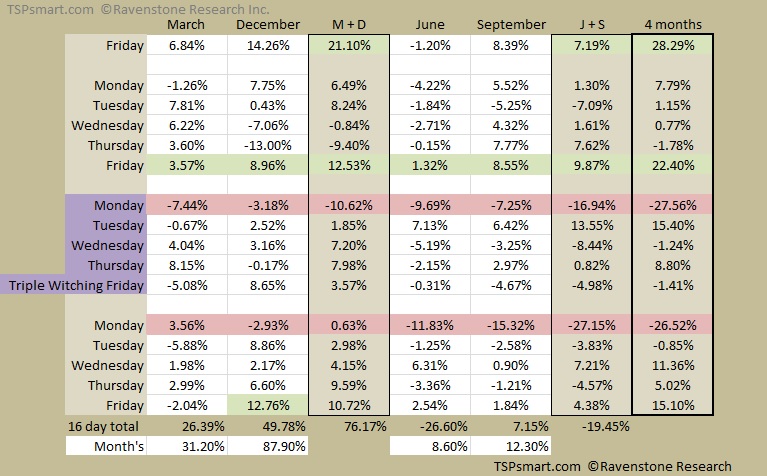-
-
-
-
Triple Witching Effects on Market
-
-
-
-
-
  TSP, Vanguard, Fidelity, Schwab, all serious investors  |
triple witching effects
If you want detailed trading day (versus) calendar day seasonal data, you might want to check out our almanacs.
We also provide the daily seasonal after eliminating the volatile bear market years - our charts show the effect. We provide the SP500 index with over 60 years of data and the SP500 and the non-sp500 companies data since 1988. All presented side-by-side and with charts that paint the picture. Many patterns stand out!
The Triple Witching Effect
on Index Funds
How does triple witching affect index funds? I took a look at the daily price action the week prior, the week of and the week after a triple witching to see if we could break out any patterns. I used the last 27 years of the Dow Jones Total US Completion Index tracked by the Government’s Thrift Savings Plan S fund and the Vanguard VXF ETF. This index tracks all US stocks minus the S&P 500 index (in other words, small and mid-sized capitalized companies). Since triple witching always falls on a Friday, we can look at its effect based on the days of the week. When we broke out the four individual months of the year that triple witching falls on, we see a larger seasonal pattern.
Triple witching hour is the last hour of the stock market trading session (3:00-4:00 P.M., New York Time) on the third Friday of every March, June, September, and December. Those days are the expiration of three kinds of securities:
- Stock market index futures;
- Stock market index options;
- Stock options
The simultaneous expirations generally increases the trading volume of options, futures and the underlying stocks, and occasionally increases volatility of prices of related securities. Wikipedia
The primary short term pattern we found was a day of the week pattern during this period. Both the Monday of triple witching week and the Monday following triple witch were significantly negative. Since the Friday prior to and after triple witching was positive, I added the Friday proceeding this period and found it was also positive. The triple witching Friday was neutral on average. The percentages in the table below are the cumulative gains/losses for each day over the 27 year period observed.
Once you divide these totals by 27 for the month’s column or by 104 for the “4 months” column you will not find they are worth trading with an index fund. But they do illustrate a seasonal pattern. It is possible that a broader day-of-week pattern exists and we are seeing a slice of it here, but this will make for future analysis.
Other researchers have mentioned a possible Monday/Friday pattern, where during bull markets Friday’s relative performance is stronger and during bear markets Fridays are weaker since traders do not want to hold stocks over the weekend. If some traders are aware of the weak Monday following triple witching, they might not want to hold positions over that weekend leading to a weaker triple -witching Friday much like during bear markets.
The 4-month totals support the strong/weak days-of-the-week pattern during this timeframe, but the seasonality of the month matters more. March and December fall into the strong seasonal months of the year as partially evidenced by their cumulative totals of 31.2% and 87.9% compared to 8.6% and 12.3% for June and September respectively. March and December Monday’s performance while basically neutral is relatively weaker than the other days of the week in these months. As for the positive Fridays, most of their performance comes from the results of December which we know is one of the strongest months of the year.
How to play this seasonal effect? Unless you are a day trader (which I do not recommend), your core retirement plan strategy should be based on investing during the seasonally strongest months of the year and avoiding the weakest. Like this short term pattern, I have found many of the short term seasonal patterns fall within the larger seasonal pattern. This requires only two trades per year, but you can always deviate from the simple seasonal strategy with part of your funds for a few of the better short-term seasonal patterns or other strong technical indications.
Note the negative seasonal pattern over the 16-day period examined in June. On average, holding the index resulted in an average loss of 1% the last 27 years. June falls within the weak season for equities, so if you follow a simply seasonal strategy you can enjoy your summer and not worry about this pattern.
The main take-away is that by reducing market exposure during the weak season, you can reduce the overall risk you assume with your retirement nest egg. With current market valuations now exceeded only by a few months during the 2000 stock market bubble, focusing on risk matters more today than usual. This simple seasonal filter is not correlated to any other analysis and not only can be used as a stand-alone strategy but can improve the risk-adjusted performance of many other strategies.
